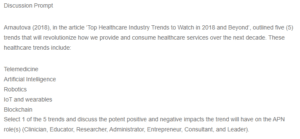The Impact of Healthcare Trends on the APN Roles-Telemedicine
Telemedicine is a fast-evolving trend in the healthcare system. Adopting telemedicine has received positive and negative criticism (Mahtta et al., 2021). Telemedicine increases access to healthcare, especially for patients in rural areas, the elderly, severely ill patients, and immobile patients. Patients can communicate with their APN nurses at any time of the day without visiting the hospital. In addition, telemedicine is efficient for chronic disease patients to report to nurses their progress, such as daily home blood pressure tests. Also, according to Mahtta et al. (2021), telemedicine decreases the cost of healthcare that would have been spent on travelling to and from the hospital or pharmacy. Notably, telemedicine enables patients to communicate with pharmacies, have their prescriptions refilled, and deliver their medications. Further, telemedicine decreases exposure to pathogens. Patients can acquire infections such as hospital-acquired pneumonia by visiting the hospital. Through telemedicine, nurses discuss with patients and recommend hospital visits for those in a critical state or those who need tests and examinations that must be performed at the hospital. Lastly, telemedicine is crucial in managing stigma in healthcare. Essentially, patients such as mental health patients and HIV/AIDS patients facing stigma can access quality health services without visiting the hospital.
Nevertheless, telemedicine comes with its challenges. Telemedicine bypasses critical access to physical examination and conducting tests on patients. Also, telemedicine is highly susceptible to hacking and data loss (Pool et al., 2022). Patients share data such as blood pressure results with their APN nurses. Telemedicine requires the use of a smartphone and access to stable internet. As such, individuals in locations with poor networks cannot rely on telemedicine. In addition, the elderly have a challenge in embracing and using technology. Most elderly individuals suffer from chronic diseases and could, therefore, benefit from telemedicine chronic disease management services, which ensure they do not frequently visit facilities where they can acquire infections (Mahtta et al., 2021). Finally, launching telemedicine is expensive since a budget is set aside for training APN nurses, healthcare professionals, and patients.
References
Mahtta, D., Daher, M., Lee, M. T., Sayani, S., Shishehbor, M., & Virani, S. S. (2021). Promise and Perils of Telehealth in the Current Era. Current cardiology reports, 23(9), 115. https://doi.org/10.1007/s11886-021-01544-w.
Pool, J., Akhlaghpour, S., Fatehi, F., & Gray, L. C. (2022). Data privacy concerns and use of telehealth in the aged care context: An integrative review and research agenda. International journal of medical informatics, p. 160, 104707. https://doi.org/10.1016/j.ijmedinf.2022.104707.
ORDER A PLAGIARISM-FREE PAPER HERE
We’ll write everything from scratch
Question
Discussion Prompt
Arnautova (2018), in the article ‘Top Healthcare Industry Trends to Watch in 2018 and Beyond’, outlined five (5) trends that will revolutionize how we provide and consume healthcare services over the next decade. These healthcare trends include:

The Impact of Healthcare Trends on the APN Roles
Telemedicine
Artificial Intelligence
Robotics
IoT and wearables
Blockchain
Select 1 of the 5 trends and discuss the potent positive and negative impacts the trend will have on the APN role(s) (Clinician, Educator, Researcher, Administrator, Entrepreneur, Consultant, and Leader).
Reference: Arnautova, Y. (2018). Top healthcare industry trends to watch in 2018 and beyond. Retrieved August 20, 2018 from https://www.globallogic.com/blogs/top-healthcare-industry-trends-to-watch-in-2018-and-beyond/


